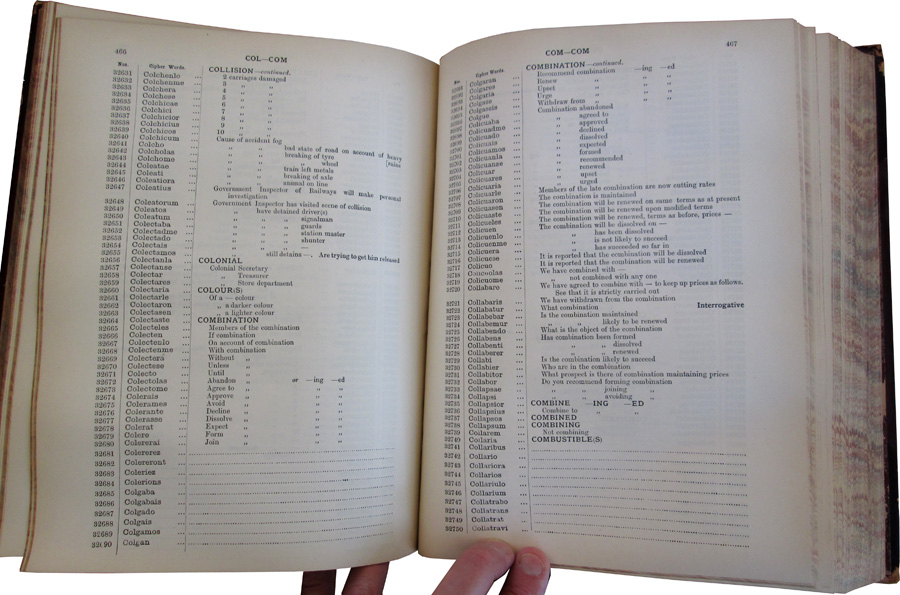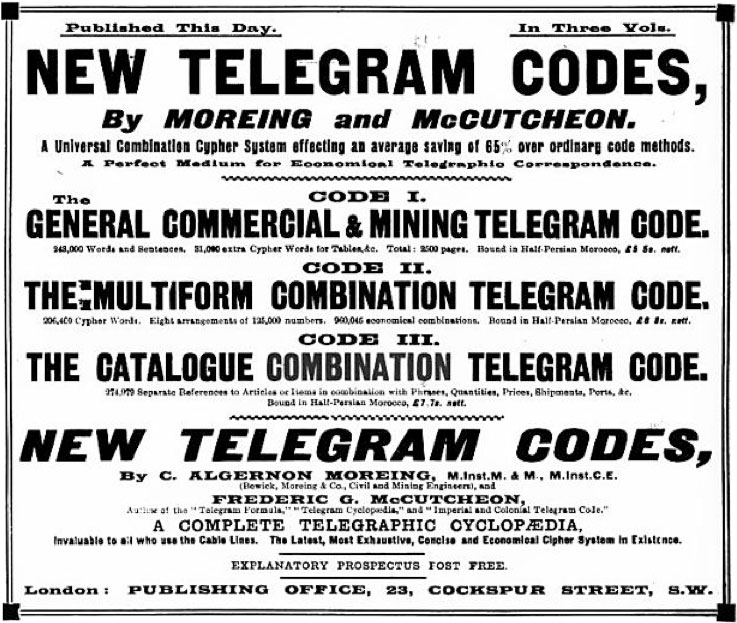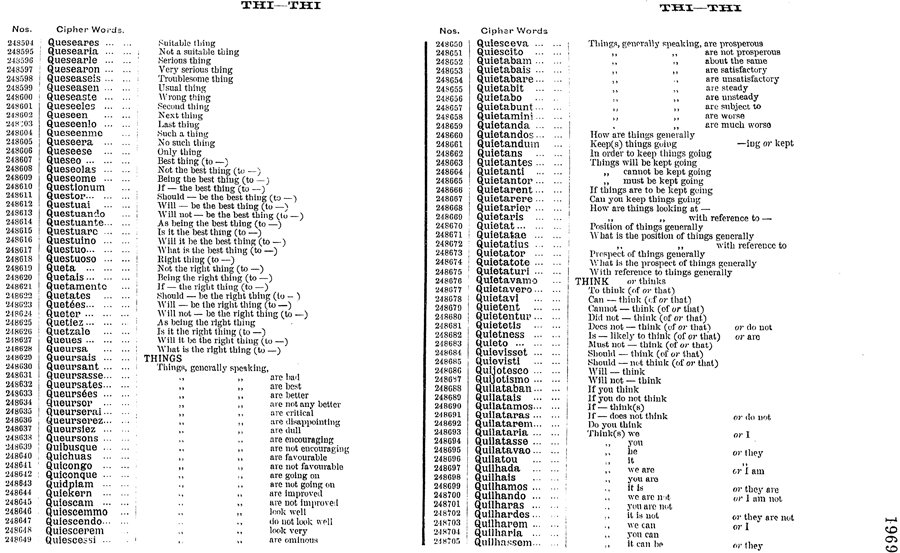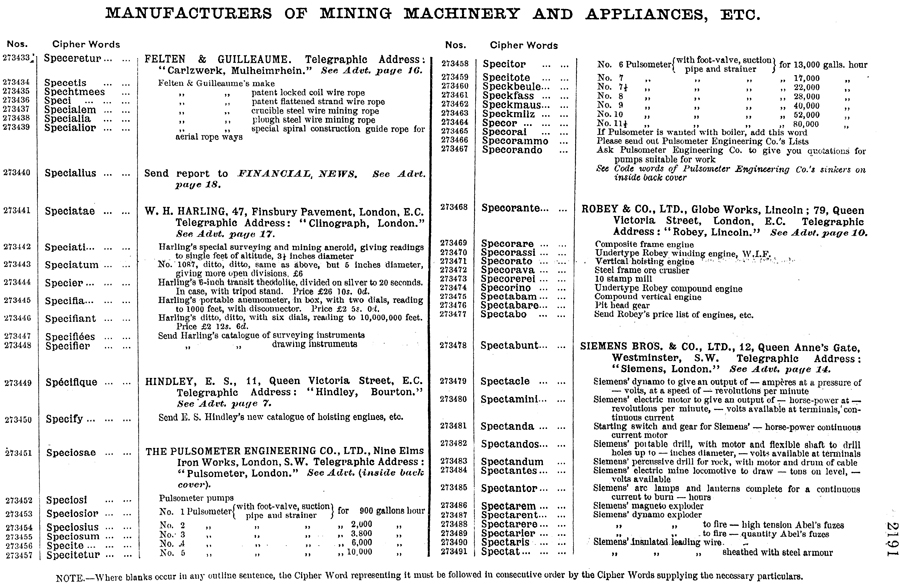telegraphic codes and message practice
scanned code directory
Codes of Frederic George McCutcheon, 1885 – 1908
draft
biographical
general characterization and evolution
| 1885 | The Telegraph Formula and Code Combiner | Marchant Singer, 47, St. Mary Axe. London |
| 1889 | The Imperial and Colonial Telegram Cyclopaedia | Marchant Singer, 47 St Mary Axe, London Lewes : H. Wolff, 64, High Street. |
| 1890 | The Imperial and Colonial Telegram Cyclopaedia | Marchant Singer, 47 St. Mary Axe, London Lewes : South Counties Press Limited) |
| 1891 | The Imperial and Colonial Telegram Cyclopaedia | Marchant Singer, 47 St. Mary Axe, London Lewes : South Counties Press Limited |
| 1894 | The Imperial and Colonial Telegram Code | 5, Lothbury, London, E.C. |
| 1897 | The General Commercial and Mining Telegram Code | William Clowes and Sons. 13, Charing Cross, S.W. London |
| 1903 | Moreing and McCutcheon. The Multiform Combination Telegram Code [Code II.] | William Clowes and Sons. 23, Cockspur St, W., and 7, Fleet Street, E.C. |
| 1903 | Moreing and McCutcheon. The Catalogue Combination Telegram Code [Code III.] | William Clowes and Sons. 23, Cockspur St, W., and 7, Fleet Street, E.C. |
| 1908 | International Banking Corporation Telegraph Code | 5, Lothbury, London, E.C. Printed by FGM, 2–4 Scrutton Street, Finsbury |
the codes
Publisher and printer addresses are given above, mainly in an attempt to locate McCutcheon himself. Full publishing information (e.g., foreign co-publishers) given at head of description of each code, below.
Only one of the above codes — The Telegram Formula and Code Combiner of 1885 — is available as a digital scan, and an incomplete one at that. McCutcheon’s collaborations with C. A. Moreing warrant mention of the latter’s two codes here:
| 1888 | C. Algernon Moreing. Telegraphic Mining Code | |
| 1891 | C. A. Moreing and Thomas Neal. The New General and Mining Telegraph Code |
Both of the Moreing codes are discussed on a separate page devoted to mining codes.
biographical note
Scant information, so far, beyond census data. The 1851 census has him living at Clapham with his father Samuel McCutcheon (age 47, Clerk Civil Service Board, born in Ireland), mother Elizabeth (39, born Norfolk) and siblings James (17), Elizabeth (16), John (14), Francis (12), William C (10), Frances (10), Maria (3), Frederic G. (3) and Philip (1). In 1871, Frederic George McCutcheon is a lodger and private secretary
in Kensington. In 1901 he is a Code Compiler
living at 8 Marischal Road in London (Lee) with wife Mary (44, born Notts, Retford). In 1911 he is listed at Kingsmead, married (but no wife named), an Author and Reviser of Telegram Codes.
Through private communication with a descendant, I understand there may have been an earlier marriage in 1877, with a woman 17 years his senior. That wife came from a family of some prominence (in the military and in colonial administration). She dies seven months after the marriage, and McCutcheon marries again (Mary Ann Dowie) in the same year.
For whom was McCutcheon a private secretary
in 1871? The position would likely have required work with telegraphic codes — indeed, a private secretary might have compiled a private code for his employer. Could McCutcheon have come in contact with Moreing at that time? or even Sir Francis Bolton, whose codes were published in 1868 and 1871? (Moreing was, in his earlier career, in charge of the foreign mining department of Sir Francis Bolton’s business.
) Bolton’s (1871) Telegraph Code is subtitled a Telegraphic dictionary of the English Language,
and its several parts share some features with McCutcheon’s tables. But this is all speculation.
To which I add one further speculation — on even thinner grounds. The last code with which McCutcheon is associated is the 1908 I.B.C. Telegraphic Code. The International Banking Corporation was established, by the United States, to handle its part of Chinese reparations for the Boxer Rebellion. C. A. Moreing (and Herbert Hoover) had been controversially involved in mining operations in China, which were shut down during the disturbances. This prompts the suspicion that this business might have come McCutcheon’s way via Moreing.
Frederic George McCutcheon, Code Expert, dies on 18 April 1915, at 36 Orlando Road, Clapham. M. A. McCutcheon, his widow, is listed as present at his death.
general characterization and evolution
McCutcheon’s codes fall under two general headings —
- straight phrase dictionary formats
(The Imperial and Colonial Telegram Code (1894) and The General Commercial and Mining Telegram Code (1897), and - various
combination
codes involving keyword indicators and tables, for grammatical constructions and for sequencing selections from tables of items, quantities, qualities, locations, etc.
All of the other McCutcheon codes fall under this broad heading, with one exception, - The Telegram Formula and Code Combiner (1885), which provides the key to the Telegram Cyclopaedia (three editions — 1889, 1890, 1891).
It is in the combination code category that matters are complicated. Here, the nature of the codewords themselves is an important factor, and McCutcheon moves through three stages: (1) codewords with three-letter meanings; (2) root and terminal codewords, also with three-letter meanings (and arranged in divisions
); and codewords (3) representing figure sequences (called combinations
) of up to 548,979 or 960,045 different combinations (the Multiform codes of 1903).
Turning from codeword construction to phrases, we find two kinds of combination: (1) flexible phrase setups (e.g., when you are not likely to have
or not / drawing out / to the utmost
), and (2) the combination of phrase elements from more focused/specific topic tables.
Finally, there is the I.B.C. Code, which is a standard figure
code whose use would involve a separate condenser (for converting figures to safe
artificial codewords.)
McCutcheon’s own favored mode would seem to be combinatorial; the pattern runs consistently through his books, from the first (1885) to the last (1908). His codes are elaborate, and would seem to build on each other. One can only imagine the carefully organized slips of paper, and the tables, on and into which auxiliaries and specialist phrase matter were entered, for reuse in subsequent codes (published and private). And numbers: everything to be conjugated in sets of 26 or, later, 99 options.
| 1885 | The Telegram Formula and Code Combiner Enabling the Transmitter of a Telegraphic Message to connect and combine any number of sentences from a given selection, without the necessity of using a fresh cipher word for every fresh sentence. Frederic George McCutcheon, comp. | London: Marchant Singer and Co., 1885 | google Bodleian (25789.d.32) MIT (Vail Collection) TK5266.M33 1885 |
337, [1] p. ; 25 cm.
The MIT (and BL) copies are
The main function of this code is to provide cipher words for 3-letter groups: those groups AAA-ZZZ (26 x 26 x 26) yield 17,576 combinations. McCutcheon increases this number by a second section of 148,044 cipher words assembled on the root and terminal
system. There are nine divisions of these (8 x 17,576 = 140,606, plus a ninth group (or division
) running AAA-KZZ another 7,436 yielding a total of 148,044 root-and-termination cipher words.
The Google scan of the Bodleian copy omits about half of the code, which is present in the BL and MIT copies. The missing section is those roots and terminals, plus instructions for their use, and various ancillary sections (i.e., index to the roots, terminations commencing and ending alphabetically, and a table showing number of letters in each termination). The BL copy was stamped 7 September 1889; it is hard to determine from the Google scan what the accession date is, but in any event, the scanned copy does not contain the root-and-terminal matter (in its nine divisions totaling 148,044 3-letter addresses) without which the Telegram Cyclopaedia — in its successively large editions of 1889, 1890 and 1891 — could not work.
It is an axiom that... the vast number of statements made regarding any given subject are capable of being classified and reduced to such a limit as to comprehend the fewest possible number of sentences which, for all ordinary purposes, will be sufficient to enable any persons to express those leading facts and probabilities which constitute what might be termed the harmonies and variations or the affirmations, negations, and interrogations relating to such subject.
(8)
McCutcheon identifies the tasks: (1) selection of subjects (domains); (2) selection of most-likely properties and relations; and (3) organization of these in menus that are consistent with known laws of thought
— that is, subject, predicate, object. He does not provide an ontology — in its sense of specification of a conceptualization
— for his system; that is, he does not articulate the rules by which subjects are reduced to their more probable harmonies and variations.
Yet his invocation of probabilities
does allow for an idea of a rough-and-ready, but potentially elaborated, statistical means.
Subjects are to be classified carefully as to the affirmations or assertions that might be made about them. Three divisions are generally found to suffice:
- Sentences as to what may or may not be affirmed as to the present state, condition, situation or position of any subject, person, or event.
- Sentences as to what may or may not be affirmed as to the probable causes which may or may not have influenced or occasioned such state, condition,
- Sentences as to the results, probable results, future probabilities or effects arising, or likely to arise, from the operation of any such influences...
When these have been carefully dissected, analysed and condensed, it will be found that the task of reducing the subject down to the very narrowest limits is not so difficult of attainment as it at first sight appears.
(10)
McCutcheon’s first example regards three subjects — a stock market report; Missouri, Kansas and Texas shares; and arrivals and departures of steamships.
Each of these subjects heads a three column table, each column containing 26 orientations
A-Z. One first builds three, three-letter ciphers for each of the subjects; then selects (1) the codeword indicating the combination of tables, and (2) the three codewords indicating the respective three-letter selections.
The sequence of orientations — those harmonics and variations — is discovered to accord nicely with the laws of thought which are known to govern our utterances on any subject... Classification and arrangement is undeviatingly followed in every extended communication of our ideas. As the simple sentence or assertion commences with the noun or subject, the verb or predicate, and the object, and may consist of only three words placed in a certain order, so we proceed step by step, still adhering to fixed arrangements of position, until we attain to the use of complex and compound sentences... when we find the same analogy preserved and the same classification and arrangement followed the substantive clause ...
<12>
Note :
The Telegram Formula and Code Combiner (1885) is the key to the location of all phrases in the three editions of The Imperial and Colonial Telegram Cyclopaedia (1889, 1890 and 1891).
It could also be used for private codes containing the phrases and sentences selected, arranged and classified as suitable to their own businesses. Indeed, most of the 40 pages of preliminary matter in the Telegram Formula explains how the combination cipher words
might be used for various subjects, and combinations of subjects, in codes compiled by firms for their own use.
In the Cyclopaedia — that seems to have been in a constant state of beta
— McCutcheon takes up that labor himself.
| 1889 | The Imperial and Colonial Telegram Cyclopaedia comprising an infinite variety of phrases and sentences, relating to legal, commercial and general subjects by Frederic George McCutcheon. Supervised and Approved by Randolph C. Want, Esq., Solicitor to the New South Wales Government. For use with McCutcheon’s Telegram Formula and Code Combiner, Containing 168,532 Cipher Words. | Marchant Singer & Co., 47, St. Mary Axe, London, and by George Robertson & Co., Melbourne and Sydney | BL J8756.g.23 MIT (Vail Collection) OVRSIZE HE7669.M33 1889 |
printer: Lewes : H. Wolff, 64, High Street.
no page numbers.
Index to Combination Tables, 1-60
for referring to any two subject tables with one cipher word.
Subject Tables 1 to 296
General Phrases, relating to miscellaneous subjects, 1-232
Special Subjects, 233-296
HE / Fatiferum table in all three editions, but the contents of the table are same only 1889 and 1891: 1890 is entirely different. I looked up “compelled” in the latter’s index, and was directed to a page of the Miscellaneous Sentences in back. has the expression, but different presentation. something like the contents of 1890 HE / Fatiferum (e.g., at what price can you buy) is found in 1889 and 1891 at FU / Fastello and FV / Fastidias.
| 1890 | The Imperial and Colonial Telegram Cyclopaedia section comprising phrases and sentences specially relating to buying, selling, offering, orders, offers, limits, &c., and general commercial subjects by Frederic George McCutcheon; for use with McCutcheon’s Telegram formula and code combiner, containing 168,532 cipher words. | [London] : Published by Marchant Singer & Co., 47 St. Mary Axe, London, and by George Robertson & Co., Melbourne and Sydney, 1890 (Lewes : South Counties Press Limited) | MIT (Vail Collection) OVRSIZE HE7669.M33 1890 |
[2], XLIV, [220], 63, [1] p. ; 36 cm.
printer: ?
| 1891 | The Imperial and Colonial Telegram Cyclopaedia section comprising phrases and sentences specially relating to financial, legal, official, and general commercial subjects : classified and tabulated under divisional headings according to the nature and description of the subjects / by Frederic George McCutcheon ; supervised as to legal and colonial requirements by Randolph C. Want, Esq. ; for use with McCutcheon’s Telegram formula and code combiner, containing 169,884 cipher words. | [London] : Published by Marchant Singer & Co., 47 St. Mary Axe, London, and by George Robertson & Co., Melbourne and Sydney, 1891 (Lewes : South Counties Press Limited) | MIT (Vail Collection) OVRSIZE HE7669.M33 1891 |
1 v. (various pagings) ; 35 cm.
printer: ?
Includes all tables, without change, from 1889 edition, but augments these (this volume is three times as thick as the earlier code). However, there is little or no incorporation of tables from the 1890 edition. Note that Randolph C. Want is named on the title page of this and the 1889 edition, but not the 1890 edition.
| 1894 | The imperial and colonial telegram code containing a selection of the most important subject-words in the English language, with 80,000 phrases and sentences for economical and secret telegraphic correspondence on commercial, financial and general subjects by Frederic George McCutcheon. | Published by Frederic G. McCutcheon, Compiler, Printer and Publisher of Telegram Codes, 5, Lothbury, London, E.C. Telegraphic Address.— HERMOPOLIS, London | MIT (Vail Collection) OVRSIZE HE7669.M328 1894 |
[2], xxi, [1], 1229, [1] p. ; 29 cm.
This copy of the Imperial and Colonial Telegram Code described here contains phrase content that is specific to Argentina and Urguguay (cattle especially, some grain, railroad construction). Some sections have been pasted over, or their codewords made available for other uses (by removal of phrase matter, e.g., names of stations along a rail line).
 |
|
| pages ii and iii, McCutcheon, The Imperial and Colonial Telegram Code (1894) MIT copy |
|
Following the one-page Preface is a Summary of Contents
(and list of Errata
), shown above. The contents read:The code is divided into the following four principal sections
:
Index to auxiliary phrases and selected verbs i to xxi.
Auxiliary phrases 1 to 86
Miscellaneous sentences in alphabetical order 100 to 1104
Selected verbs combined with auxiliary phrases 1097 to 1150
The omitted pages described in the errata are not so much errors, but represent sections of private/specific content that appeared in one manifestation of this edition, but that have been removed for this copy (or set of copies).
The index
(21 pages in all) is an important part of a dictionary, whose expressions might be found in either of two auxiliaries sections, or in the main miscellaneous sentences
section.
 |
|
| pp466-467, McCutcheon, The Imperial and Colonial Telegram Code (1894) MIT copy) |
|
It may be that this code was designed for a consortium of firms and investors with interests in Argentina and Uruguay; the combination
would refer to such an entity. How many participants might have been involved? No list is included within the code.
 |
|
| pages 1088 and 1097 (not spread), McCutcheon, The Imperial and Colonial Telegram Code (1894) MIT copy) |
|
Page 1097 is one of several in which selected verbs are shown in combination with auxiliaries. Earlier pages in the same code show auxiliaries with verbs to be, to have, etc., and not in tabular form as shown here.
Note :
The Telegram Encyclopaedia (the three iterations I have examined) each depended on the codewords provided by the Telegram Formula to work. Those codewords functioned like the cipher addresses of all the sentence and auxiliary phrase matter — not only the addresses, but indicators of sequences by which tables were to be accessed. What the three cyclopaedia provided was the thematic index.
Things changed with the next sequence of codes. The Moreing and Mccutcheon code of 1897 was relatively straightforward; the Multiform and Catalogue combination codes referred to no external address book [check].
 |
|
| advertisement in The Electrical Review (Supplement), December 23, 1903. The three codes were reviewed in The Electrical Review on December 11 — here. |
|
blah blah blah.
| 1897 | The General Commercial and Mining Telegram Code comprising 274,000 words and phrases, selected and arranged upon an analytical and grammatical method. preceded by a complete index to the most important words in the English language, with grous of words expressing ideas closely related to suggest and facilitate the compilation of sentences. also including economical combination tables for transmitting the name of any twenty-five stocks or shares, etc., with phrase, price, quantity, etc., etc. together with The Official Vocabulary of Cipher Words, prepared in accordance with the decisions of the International Telegraph Conference of Paris. by C. Algernon Moreing, etc and Frederick G. McCutcheon, | [London] : William Clowes and Sons, Limited, 13, Charing Cross, S.W. 1897 Price Five Guineas. | BL 1805.aa.16 |
7 x 10 x 4 inches, 2204 pages
its preface elucidates some of the issues attendant to compilation of sentences and sections of sentences, the object being to leave the phrases more frequently available
for diverse combinations, by omission of qualifying clauses or other subjects or objects that would fix it. good examples are given on iii and iv.
 |
|
| p1969 (from poor photocopy), Moreing and McCutcheon, General Commercial and Mining Telegram Code (1897) | |
blah blah blah.
 |
|
| p2191 (from poor photocopy), Moreing and McCutcheon, General Commercial and Mining Telegram Code (1897) | |
| 1903 | The Multiform Combination Telegram Code [Code II.] consisting of 206,460 cipher words compiled in accordance with the Regulations of the International Telegraphic Conventions, with Eight different arrangements of 125,000 numbers and a multiform system of combination for Tabulating Special Sentences, etc., in combination with amounts of money, names of firms, articles, quantities, prices, shipments, qualities, assortments, sizes, dimensions, weights, etc., etc., affording 960,045 economical numerical combinations whereby either 2, 3, 4, 5, 6, 7, 8, 9, 10, 11, 12, 13, 14, or 15 references can be indicated with only one cipher word. by C. Algernon Moreing, etc and Frederick G. McCutcheon, | [London] : 1903 | BL 1805.f.1 |
?
| 1903 | The Catalogue Combination Telegram Code [Code III.] specially arranged for telegraphing with reference to one or more catalogues or lists of articles or items Numbered variously from 1 to 22, etc., up to 1 to 15,000, with varying ranges of Prices and Quantities in combination with phrases relating to purchases, sales, offers, orders, limits shipments, markets, prices, quantities, ports and places, etc., by means of series or groups of selected subjects effecting an average saving over ordinary code methods of 65 per cent. Prices, Amounts of Money, Exchanges, etc., in British and Foreign Currencies, Selected Numbers, Fractions, Decimals, Quantities, Measurements, etc. Combinations of phrases Referring to Banking by C. Algernon Moreing, etc and Frederick G. McCutcheon, | [London] : 1903 | BL 1805.f.1 (same as Multiform Combination code. |
?
| 1908 | International Banking Corporation Telegraph Code Tables of Phrases Nos. 0,000,000,000 to 1,154,099,999 Combinations of the Principal Grammatical Phrases Compiled by Frederic G. McCutcheon | Frederic G. McCutcheon, 5, Lothbury, London, E.C. Printed by Frederic G. McCutcheon, 2–4, Scrutton Street, Finsbury. | private collection |
The IBC code measures 20 x 14 inches, and two inches thick: [5], iv-xxvi, [1], 2-653. It is designed for verbatim
message assembly, and as a figure code would have required a separate condenser.
The instructions begin with a reference to the Telegraphic Conference of 1903 which, by permitting the use of artificial cipher words, rendered it possible to greaty increase the economy of Telegraphic Code correspondence, by enabling combinations of Words and Phrases to be effected and indicated by the use of only one Cipher Word.
Such combinations had not previously been possible to any large extent.